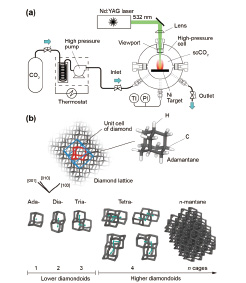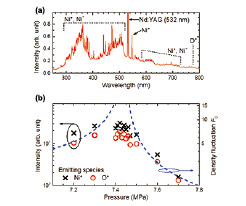Pulsed Laser Ablation in Supercritical CO2 for Nanomaterials Synthesis
T. Kato, K. Terashima, and M. Baba
Pulsed laser ablation (PLA) is a versatile technique that allows the fabrication of high-quality thin films in vacuum, and it has also been increasingly used in liquids for the formation and functionalization of nanomaterials. Compared to gases and liquids, PLA in supercritical fluids (SCFs) offers further advantages for materials synthesis because of the favorable thermophysical properties of SCFs. For instance, in SCFs, coagulation of nanomaterials can be avoided because of the possibility to tune the solubility of the synthesized materials. Furthermore, certain thermophysical properties of SCFs, for instance the density fluctuation FD, which characterizes the inhomogeneity of the local molecular density, present a local maximum at the critical point.

Fig. 1. (a) Schematic of pulsed laser ablation (PLA) in supercritical carbon dioxide (scCO2). (b) Relation of diamondoids and diamond lattice and molecular structures of lower and higher diamondoids.

Fig. 2. (a) Optical emission spectrum acquired from PLA in scCO2 near the critical point (b) Variation of emission intensities of Ni* and O* atomic lines and density fluctuation FD of CO2 fluid as a function of pressure. [4]
We have applied PLA in supercritical xenon (scXe) and carbon dioxide (scCO2) near their critical points to the synthesis of diamondoids, which are C(sp3)-C(sp3) hybridized hydrogen-terminated molecules whose cage structures can be superimposed on a diamond lattice [1] (Fig. 1). Despite their promising physical properties and potential for a wide range of applications, the availability of high-order diamondoids is still very limited [2]. Using the first diamond member, adamantane, as a precursor and seed, we succeeded in the synthesis of higher diamondoids that had not been synthesized before, utilizing the dense and highly non-equilibrium reaction field of PLA plasmas in SCFs near the critical point [3].
Our joint group’s study now aims to reveal the dynamics of the PLA reaction fields generated in SCFs using spectroscopic diagnostic equipment in the Spectroscopy Section of the Materials Design and Characterization Laboratory, for further improvement of the nanomaterials synthesis. Optical emission spectroscopy (OES) gave us information of target- and solvent-originated excited species in the PLA reaction field. We found that the emission intensities of both Ni (target) and O atoms (originating from the CO2 solvent) reached local maxima that could be correlated to the change of the density fluctuation FD [4] (Fig. 2). This is the first report on the critical anomaly in PLA dynamics in the world. The local maxima of emission intensities are probably due to the enhancement of the plasma excitation and effective quenching resulting from the large FD, and it also means that the large number of excited species can contribute to the nanomaterials synthesis near the critical point. These experimental approaches for investigating the PLA dynamics will strongly assist the optimization of PLA nanomaterials synthesis in SCFs.
References
- [1] S. Nakahara, S. Stauss, H. Miyazoe, T. Shizuno, M. Suzuki, H. Kataoka, T. Sasaki, and K. Terashima, Appl. Phys. Express 3, 096201 (2010).
- [2] J. E. Dahl, S. C. Liu, and R. M. K. Carlson, Science 299, 96 (2003).
- [3] S. Nakahara, S. Stauss, T. Kato, T. Sasaki, and K. Terashima, J. Appl. Phys. 109, 123304 (2011).
- [4] T. Kato, S. Stauss, S. Kato, K. Urabe, M. Baba, T. Suemoto, and K. Terashima, Appl. Phys. Lett. 101, 224103 (2012).
